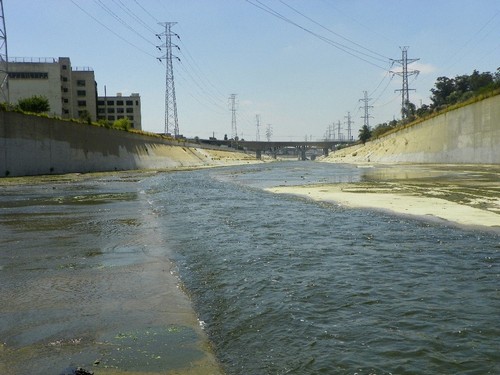 Research Areas > Contaminants > Statewide CEC Prioritization
Research Areas > Contaminants > Statewide CEC Prioritization
Project: Prioritization of Contaminants of Emerging Concern for Statewide Monitoring and Assessment
Background and Objectives
Environmental managers are challenged with addressing contaminants of emerging concern (CECs) in the face of limited knowledge about their sources, pervasiveness, and effects. Beginning in 2009, the State of California convened a panel of experts to provide recommendations on how current knowledge of CECs should influence regulatory activities, first to implement monitoring as part of the State’s Recycled Water Policy, followed by ambient waters receiving POTW and stormwater discharge. The panels generated CEC monitoring recommendations for recycled and receiving waters that are now being implemented or considered for pilot studies statewide. In addition, the panels identified the need to develop more comprehensive, efficient, and relevant monitoring and assessment methods for CECs (called bioanalytical screening tools).
This project aims to fill the occurrence and toxicological data gaps needed to prioritize CECs for statewide monitoring using a risk-based framework.
Status
This project was initiated in 2011 with anticipated completion in 2014.
Methods
Pilot monitoring study for CECs in aquatic ecosystems
To vet the initial recommendations set forth by the panel in aquatic ecosystems, SCCWRP will develop a pilot study monitoring plan to address (1) targeted monitoring requirements (e.g., which CECs to monitor in various matrices, scenarios, and candidate watersheds/water bodies; where and how often to monitor; and QA/QC measurement guidelines); (2) special studies to evaluate the efficacy of cutting edge technology; and (3) quality assurance/quality control guidelines. Technical and stakeholder advisors will provide input and feedback to SCCWRP in developing this study plan.

The highly channelized Los Angeles and other urban rivers in Southern California receive discharge from water reclamation plants.These constitute their main source of water during low flow summer conditions.
Occurrence and fate of CECs in coastal, effluent-dominated rivers
As described in the ecosystems panel report, waterways that receive discharge of treated municipal wastewater effluent from publicly operated treatment works (POTWs) are subject to maximum exposure to CECs contained in the effluent, particularly during summer low flow conditions. The ecosystems panel recommended eight individual CECs for monitoring. A series of studies sponsored by the Los Angeles Regional Board were designed and carried out to generate a robust database for CEC occurrence for this scenario. In Phase 1 of the study, water samples from multiple stations along the Los Angeles and San Gabriel rivers were collected and analyzed for a broad suite of CECs (>60). Although source contributors and discharge/water management practices differed, the study concluded that POTWs were the major source of detected CECs in these systems. Moreover, the channelized hydrology and lack of natural riparian habitat and soft bottom resulted in little attenuation of discharged CECs. In Phase 2, the water sampling will be applied to the Santa Clara River, a system whose middle reach is less modified than the Los Angeles or San Gabriel rivers. Also in Phase 2, sediment and fish tissue are to be collected to comment on the multimedia fate of CECs in these systems.
Calendar
Date
| Event | Related Materials |
| 2011 |
| October 30
| Phase 1 River Study Commenced | |
| 2012 |
| June 30 | Phase 1 River Study Report released | |
| 2013 |
| August 22
| Santa Clara River Sampling - Event #1 | |
| September 12-13
| Statewide CEC Monitoring Plan Meeting #1 | Agenda
Presentations
|
| October
| Santa Clara River Sampling - Event #2 | |
| 2014 |
| April 30
| Targeted Monitoring and Special Study Design Requirements
| Draft |
| May
| Statewide CEC Monitoring Plan Meeting #2 | Presentation
Meeting Summary
|
| July 30
|
QA/QC Guidelines
| Draft |
| Dec 15
| Statewide CEC Monitoring Plan Meeting #3 | Agenda (Final)
Design Requirements (Revised) |
| 2015 |
| Jan 31
| Targeted Monitoring, Special Study and QA/QC Guidance - Final | Final Report |
| Mar 30
| Phase 2 River Study- Final Report Due | |
Partners
This project is being performed in collaboration with the University of Arizona, Colorado School of Mines, the Los Angeles County Sanitation Districts, as well as members of the science advisory panel and stakeholder advisory committee listed below.
Science Advisory Panel Members:
Stakeholder Advisors:
- Sara Aminzadeh (CA Coastkeeper Alliance)
- Rich Breuer (State Water Resources Control Board)
- Geoff Brosseau (California Stormwater Quality Association)
- Rebecca Sutton (San Francisco Estuary Institute)
- Philip Friess (Tri-TAC)
- Rich Gossett (Physis Environmental Labs)
- Adam Laputz (Central Valley Regional Board)
- Thomas Mumley (San Francisco Bay Regional Board)
- Deborah Smith (Los Angeles Regional Board)
This page was last updated on: 4/13/2015